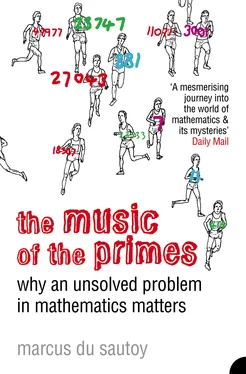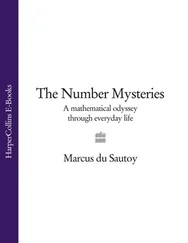However, nearly a year after Piazzi’s planet had vanished, a twenty-four-year-old German from Brunswick announced that he knew where astronomers should find the missing object. With no alternative prediction to hand, astronomers aimed their telescopes at the region of the night sky to which the young man had pointed. As if by magic, there it was. This unprecedented astronomical prediction was not, however, the mysterious magic of an astrologer. The path of Ceres had been worked out by a mathematician who had found patterns where others had only seen a tiny, unpredictable planet. Carl Friedrich Gauss had taken the minimal data that had been recorded for the planet’s path and applied a new method he had recently developed to estimate where Ceres could be found at any future date.
The discovery of Ceres’ path made Gauss an overnight star within the scientific community. His achievement was a symbol of the predictive power of mathematics in the burgeoning scientific age of the early nineteenth century. Whereas the astronomers had discovered the planet by chance, it was a mathematician who had brought to bear the necessary analytic skills to explain what was going to happen next.
Although Gauss’s name was new to the astronomical fraternity, he had already made his mark as a formidable new voice in the mathematical world. He had successfully plotted the trajectory of Ceres, but his real passion was for finding patterns in the world of numbers. For Gauss, the universe of numbers presented the ultimate challenge: to find structure and order where others could only see chaos. ‘Child prodigy’ and ‘mathematical genius’ are titles that are bandied about far too often, but there are few mathematicians who would argue with these labels being attached to Gauss. The sheer number of new ideas and discoveries that he produced before he was even twenty-five seems to defy explanation.
Gauss was born into a labourer’s family in Brunswick, Germany, in 1777. At the age of three he was correcting his father’s arithmetic. At the age of nineteen, his discovery of a beautiful geometric construction of a 17-sided shape convinced him that he should dedicate his life to mathematics. Before Gauss, the Greeks had shown how to use a compass and straight edge to construct a perfect pentagon. No one since had been able to show how to use this simple equipment to construct other perfect, so-called regular polygons with a prime number of sides. The excitement that Gauss experienced when he found a way to build this perfect 17-sided shape prompted him to start a mathematical diary which he would keep for the next eighteen years. This diary, which remained in the family’s hands until 1898, has become one of the most important documents in the history of mathematics, not least because it confirmed that Gauss had proved, but failed to publish, many results that it took other mathematicians well into the nineteenth century to rediscover.
One of Gauss’s greatest early contributions was the invention of the clock calculator. This was an idea, rather than a physical machine, that unleashed the possibility of doing arithmetic with numbers that had previously been considered too unwieldy. The clock calculator works on exactly the same principle as a conventional clock. If your clock says it’s 9 o’clock, and you add 4 hours, the hour hand moves round to 1 o’clock. Gauss’s clock calculator would therefore return the answer 1 rather than 13. If Gauss wants to do a more complicated calculation such as 7 × 7, the clock calculator would come up with the remainder that is left after dividing 49 = 7 × 7 by 12. The result would again be 1 o’clock.
It is when Gauss wants to calculate the value of 7 × 7 × 7 that the power and speed of the clock calculator begins to emerge. Instead of multiplying 49 by 7 again, Gauss can just multiply the last answer (which was 1) by 7 to get the answer 7. So without having to calculate what 7 × 7 × 7 was (which happens to be 343), he still knew with little effort that it gave remainder 7 on division by 12. The power of the calculator came into its own when Gauss started exploring big numbers that lay beyond his computational reach. Although he had no idea what 7 99was, his clock calculator told him that the number gave remainder 7 on division by 12.
Gauss saw that there was nothing special about clocks with 12 hours on their face. He introduced the idea of doing clock arithmetic, sometimes called modular arithmetic, with any number of hours on the clock face. So, for example, if you enter 11 into a clock calculator divided into 4 hours, the answer is 3 o’clock since 11 leaves remainder 3 on division by 4. Gauss’s account of this new sort of arithmetic revolutionised mathematics at the turn of the nineteenth century. Just as the telescope had allowed astronomers to see new worlds, the development of the clock calculator helped mathematicians to discover in the universe of numbers new patterns which had been hidden from view for generations. Even today, Gauss’s clocks are central to the security of the Internet, which utilises calculators whose clock faces bear more hours than there are atoms in the observable universe.
Gauss, the child of a poor family, was lucky to get the chance to capitalise on his mathematical talent. He was born into an age when mathematics was still a privileged pursuit funded by noble courts and patrons, or practised by amateurs such as Pierre de Fermat in their spare time. Gauss’s patron was the Duke of Brunswick, Carl Wilhelm Ferdinand. Ferdinand’s family had always supported the culture and economy of their dukedom. Indeed, his father had founded the Collegium Carolinum, one of the oldest technical universities in Germany. Ferdinand was imbued with his father’s ethos that education was the foundation of Brunswick’s commercial successes, and he was always on the lookout for talent deserving of support. Ferdinand first came across Gauss in 1791, and was so impressed with his abilities that he offered to finance the young man to attend the Collegium Carolinum so that he could realise his obvious potential.
It was with much gratitude that Gauss dedicated his first book to the duke in 1801. This book, entitled Disquisitiones Arithmeticae , collected together many of Gauss’s discoveries about the properties of numbers that he had recorded in his diaries. It is generally acknowledged as the book that heralded the birth of number theory as a subject in its own right, not just a ragbag collection of observations about numbers. Its publication is responsible for making the subject of number theory, as Gauss always liked to call it, ‘the Queen of Mathematics’. For Gauss, the jewels in the crown were the primes, numbers which had fascinated and teased generations of mathematicians.
The first tentative evidence that humankind knew about the special qualities of prime numbers is a bone that dates from 6500 BC. Called the Ishango bone, it was discovered in 1960 in the mountains of central equatorial Africa. Marked on it are three columns containing four groups of notches. In one of the columns we find 11, 13, 17 and 19 notches, a list of all the primes between 10 and 20. The other columns do seem to be of a mathematical nature. It is unclear whether this bone, housed in Belgium’s Royal Institute for Natural Sciences in Brussels, truly represents our ancestors’ first attempts to understand the primes or whether the carvings are a random selection of numbers which just happen to be prime. Nevertheless, this ancient bone is perhaps intriguing and tantalising evidence for the first foray into the theory of prime numbers.
Some believe that the Chinese were the first culture to hear the beating of the prime number drum. They attributed female characteristics to even numbers and male to odd numbers. In addition to this straight divide they also regarded those odd numbers that are not prime, such as 15, as effeminate numbers. There is evidence that by 1000 BC they had evolved a very physical way of understanding what it is, amongst all the numbers, that makes prime numbers special. If you take 15 beans, you can arrange them in a neat rectangular array made up of three rows of five beans. Take 17 beans, though, and the only rectangle you can make is one with a single row of 17 beans. For the Chinese, the primes were macho numbers which resisted any attempt to break them down into a product of smaller numbers.
Читать дальше












